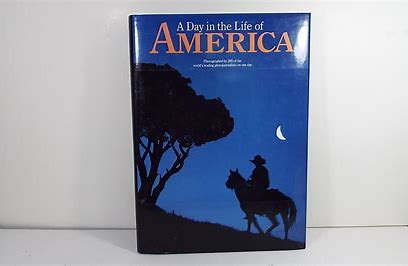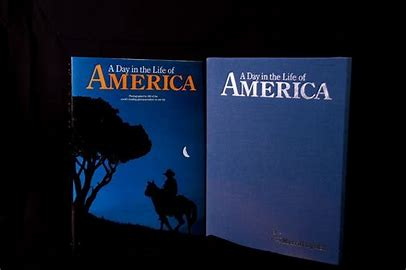Content Menu
● Historical Context
>> The Cultural Landscape of 1986
● Themes Explored
>> Diversity of American Life
>> Ordinary vs. Extraordinary
>> Social Issues
● Notable Contributions from Photographers
>> Emerging Photographic Styles
● Visual Style and Presentation
>> Cohesive Narrative Structure
● Lasting Impact on Photography
>> Inspiration for Future Projects
>> Cultural Reflection
● Conclusion
● Questions & Answers
>> 1. What was the purpose behind 'A Day in the Life of America'?
>> 2. How many photographs were taken for this project?
>> 3. Who were some notable photographers involved in this project?
>> 4. What themes are explored in 'A Day in the Life of America'?
>> 5. How has 'A Day in the Life of America' influenced photography?
'A Day in the Life of America' is a remarkable photo book that captures the essence of American life through the lens of 200 of the world's leading photographers. Released in 1986, this ambitious project aimed to document a single day—May 2, 1986—in the diverse and vibrant tapestry of American culture. The book features a selection of around 275 photographs from an original pool of 245,000 images, showcasing a wide array of moments that reflect both the ordinary and extraordinary aspects of life in America.
This article delves into various facets of the book, exploring its historical context, themes, notable contributions from photographers, and its lasting impact on photography and American culture.

Historical Context
The project was spearheaded by Rick Smolan and David Cohen, who had previously executed similar projects in Australia, Hawaii, Canada, and Japan. These earlier efforts laid the groundwork for what would become a monumental undertaking in documenting American life. The idea was simple yet profound: gather top photographers to capture everyday moments across the country within a single 24-hour period.
On that day in May, photographers were dispatched to various locations—from bustling urban centers to serene rural landscapes—to document life as it unfolded. The resulting images provide a snapshot not only of daily routines but also of significant cultural events and social issues prevalent at the time.
The Cultural Landscape of 1986
To fully appreciate 'A Day in the Life of America,' it is essential to consider the cultural landscape of 1986. This was a period marked by significant political changes, economic challenges, and evolving social dynamics. The Cold War was still ongoing, influencing international relations and domestic policies. The United States was grappling with issues such as racial tensions, economic inequality, and shifting family structures.
The photographs taken on May 2, 1986, serve as historical markers that reflect these broader societal trends. For instance, images depicting protests or community gatherings reveal grassroots movements advocating for civil rights and social justice. In contrast, other photographs capture scenes of leisure and celebration that highlight the resilience and diversity inherent in American culture.
Themes Explored
Diversity of American Life
One of the most striking aspects of 'A Day in the Life of America' is its portrayal of the country's diversity. The photographs encompass a wide range of experiences, from family gatherings and community events to individual moments of solitude. This diversity reflects not only geographical differences but also variations in socioeconomic status, ethnicity, and lifestyle.
For example, one section features images from rural areas showcasing agricultural life—farmers tending to their crops or families enjoying picnics in open fields—while another section captures urban life with bustling city streets filled with people from various backgrounds engaging in their daily routines. This juxtaposition emphasizes how different environments shape experiences while also highlighting shared human emotions such as joy, sorrow, love, and hope.
Ordinary vs. Extraordinary
The book beautifully juxtaposes ordinary moments with extraordinary events. For instance, while many images depict mundane activities like grocery shopping or commuting to work, others capture significant cultural milestones such as weddings or first communions. This blend emphasizes that every moment—no matter how small—contributes to the larger narrative of American life.
In one photograph, a child rides a bicycle down a quiet suburban street; in another image nearby, a couple celebrates their wedding day surrounded by family and friends. These contrasting scenes remind us that life's beauty lies not only in grand occasions but also in simple pleasures—moments that often go unnoticed yet form the fabric of our daily existence.
Social Issues
In addition to celebrating everyday life, some photographs address pressing social issues. Images depicting poverty, violence, and cultural clashes serve as poignant reminders that America is a nation grappling with complex challenges. For example, one photograph shows a mugging in progress while another captures a Ku Klux Klan cross-burning. These stark contrasts highlight the multifaceted nature of society and provoke thought about America's ongoing struggles.
Moreover, certain images focus on marginalized communities often overlooked by mainstream media. Photographers captured poignant moments that tell stories about resilience amidst adversity—such as families living in impoverished neighborhoods or individuals participating in community activism. By including these narratives within the larger framework of American life, 'A Day in the Life of America' encourages viewers to confront uncomfortable truths while fostering empathy for those whose experiences differ from their own.
Notable Contributions from Photographers
The project brought together an impressive roster of photographers, many of whom were already well-established in their careers.
- Mary Ellen Mark: Known for her powerful portraits, Mark's work often focuses on marginalized communities. Her photograph of a young woman with Down syndrome preparing for an event is both touching and thought-provoking. It encapsulates not just her subject's individuality but also broader themes related to acceptance and love within families.
- David Hume Kennerly: A former White House photographer and Pulitzer Prize winner, Kennerly's images often encapsulate pivotal moments in history. His contributions to this project add depth and context to the portrayal of American life. One notable image shows President Reagan speaking at an event; it serves as a reminder of political leadership during turbulent times.
- John White Jr.: Another Pulitzer Prize-winning photographer whose work captures everyday moments with striking clarity. His images resonate with viewers by portraying relatable scenes that evoke nostalgia—such as children playing outside or families gathering around dinner tables.
These photographers brought their unique perspectives and styles to the project, enriching its overall narrative.
Emerging Photographic Styles
In addition to established photographers contributing their expertise to 'A Day in the Life of America,' many emerging talents had their work featured alongside them—a testament to how collaborative projects can elevate lesser-known voices within photography circles.
This blending created an opportunity for diverse styles ranging from documentary realism to more artistic interpretations through creative compositions or experimental techniques like double exposures or long exposures capturing movement over time.
Visual Style and Presentation
The visual presentation of 'A Day in the Life of America' is noteworthy. The book features a mix of color and black-and-white photographs that enhance its storytelling capacity. The layout is designed to guide readers through various themes while allowing individual images to stand out.
The opening images set a serene tone with dawn breaking over landscapes and families waking up together. As readers progress through the book, they encounter vibrant scenes filled with life—children playing, couples celebrating milestones, and individuals engaged in daily tasks.
Cohesive Narrative Structure
Each section within 'A Day in the Life of America' is carefully curated to create a cohesive narrative structure that flows seamlessly from one theme to another while maintaining visual interest throughout its pages.
For example:
- Morning Rituals: This section captures early morning routines—people sipping coffee at diners or children getting ready for school—setting an intimate tone for readers as they witness familiar rituals shared across households nationwide.
- Community Engagement: Following morning rituals are images portraying community gatherings such as fairs or parades where neighbors come together celebrating local culture through food stalls filled with delicious treats accompanied by lively music performances.
- Reflections on Society: The final sections delve deeper into societal issues highlighting struggles faced by certain communities while also showcasing resilience found within them—a powerful reminder about hope amidst adversity.

Lasting Impact on Photography
'A Day in the Life of America' has had a significant influence on both photography and cultural documentation since its release. It set a precedent for collaborative photographic projects that seek to capture collective experiences over specific timeframes.
Inspiration for Future Projects
The success of this book inspired numerous similar projects worldwide encouraging photographers to explore their own cultures through collective lenses. It demonstrated how photography could serve as a powerful medium for storytelling and cultural preservation.
Projects like 'A Day in the Life' have since emerged globally—from documenting daily life across countries like Japan or Brazil—to capturing significant historical events such as natural disasters or political movements through collaborative efforts involving local photographers who understand their communities intimately.
Cultural Reflection
In addition to its artistic value, this photo book serves as an important historical document reflecting societal norms and values from 1986. It offers contemporary readers insights into past lifestyles while prompting discussions about how much has changed—or remained the same—in American society over time.
As we navigate current challenges related to social justice movements or environmental crises today—it becomes increasingly vital for us not only reflect upon our history but also learn from it so we can build more inclusive futures together moving forward.
Conclusion
'A Day in the Life of America' stands as a testament to the power of photography in capturing fleeting moments that define our collective existence. Through its rich tapestry of images featuring diverse subjects—from joyful celebrations among families enjoying picnics outdoors—to sobering portrayals addressing pressing social issues—it invites viewers not only reflect upon their own lives but appreciate diverse experiences shaping our nation today further enriching our understanding about what it means truly live together harmoniously despite differences we may have amongst each other along this journey called life itself!
As we look back at this remarkable project nearly four decades later—it remains relevant both artistically inspiring future generations while serving historically significant snapshot reminding us all how interconnected we truly are regardless where we come from!

Questions & Answers
1. What was the purpose behind 'A Day in the Life of America'?
The purpose was to document everyday life across America on a single day—May 2, 1986—through the lenses of leading photographers capturing both ordinary moments and significant cultural events.
2. How many photographs were taken for this project?
Approximately 245,000 photographs were taken by 200 photographers; however only around 275 were selected for inclusion in the final book.
3. Who were some notable photographers involved in this project?
Notable photographers included Mary Ellen Mark David Hume Kennerly John White Jr., all renowned for their impactful work in photojournalism.
4. What themes are explored in 'A Day in the Life of America'?
The book explores themes such as diversity within American life juxtaposition between ordinary extraordinary moments social issues affecting society at that time.
5. How has 'A Day in the Life of America' influenced photography?
The book has inspired numerous collaborative photographic projects worldwide serves as an important historical document reflecting societal norms from its time while encouraging discussions about cultural evolution.
































